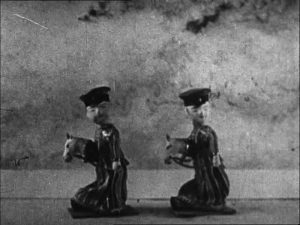Animation is the art of making inanimate objects appear to move, usually by showing a sequence of photos rapidly in succession. History’s first recorded animator is Pygmalion of Greek and Roman mythology, a sculptor who created a figure of a woman so perfect that he fell in love with her and begged Venus to bring her to life. Although, the first animation made was in 1907 by Émile Cohl with ‘Japon de faintasie’.

The theory of animated cartoon precedes the invention of the cinema by 50 years. Early experimenters worked to create pieces for Victorian parlours or magic-lantern shows, which were a popular form of entertainment. If drawings of the stages of an action were shown in fast succession, the human eye would perceive them as a continuous movement.
Animation comes in many different forms. There are traditional stop motion animations, computer-generated imagery (CGI), ocular toys from the 17th century, and even pottery from the ancient greeks. People consider ancient greek pottery to be an early from of animation due to the scenes of movement around the pieces like a comic strip. I like stop motion because it reminds me of the homemade lego films from my childhood but then the big production Lego Movies also. However, those were made with CGI to mimic stop motion, down to lego piece imperfections and limited movements. I watched this video explaining the technicalities of it, while I enjoyed the video I am not at that level of animation.
When I I think of significant animation films I think of Disney. These films were a large part of my childhood, and for a large majority of people of all ages. The creation of Mickey Mouse was the start of an empire. Although Snow White and the Seven Dwarfs (1937) not the first animated feature, it was the first to use up-to-the-minute techniques and the first to receive a wide, Hollywood-style release.
Another significant animation house is Pixar which has a more bubbly generic style across the majority of their films like The Incredibles (2004). However, recently animation studios have started to experiment with other styles in films like: Spiderman: Into the Spider-verse (2018) and Meet the Mitchells (2021). Specifically, in the Spider-Man films there was interesting observations made about the animation techniques.
First, different characters are animated on different frame rates. In a scene, Miles Morales and Peter B Parker are animated on different frames to show how they are out of synch, but later in they are synchronised showing their relationship and character development. So “On Ones” means that every Frame the movement of a character is updated, but “On Twos” means that every other Frame the movement is updated. So the Character seems to slide over the screen for one frame and then update and then slide again and then update again and so on. Another amazing detail is the animation of the character, Hobie Brown, who is animated ‘on threes’ because this is how the animators decide to illustrate his ’punk’ nature. His jacket is also animated different to the rest of his body to further enhance the choppy look. I will look further into different animation styles to see what choices I make will effect how the audience perceives my animation/characters.
Although, I would argue that the most famous animation is Japanese anime. I grew up watching anime and so did my father in South East Asia. He watched Dragon Ball Z and I watched Pokemon. Nowadays, my favourite anime is Attack on Titan. In seasons 1 to 3 was animated by Wit studio and mainly hand drawn animations which is why it took a long time to come out. When MAPPA studios took over a lot of work was completed in a short amount of time. A lot of scenes were made using CGI but it was also alleged that working conditions at MAPPA were unethical.
As a result from my research I know that I want to mix stop motion and digitally animated techniques e.g. scanning in traditional textures and using a stop motionesque technique on procreate or photoshop.